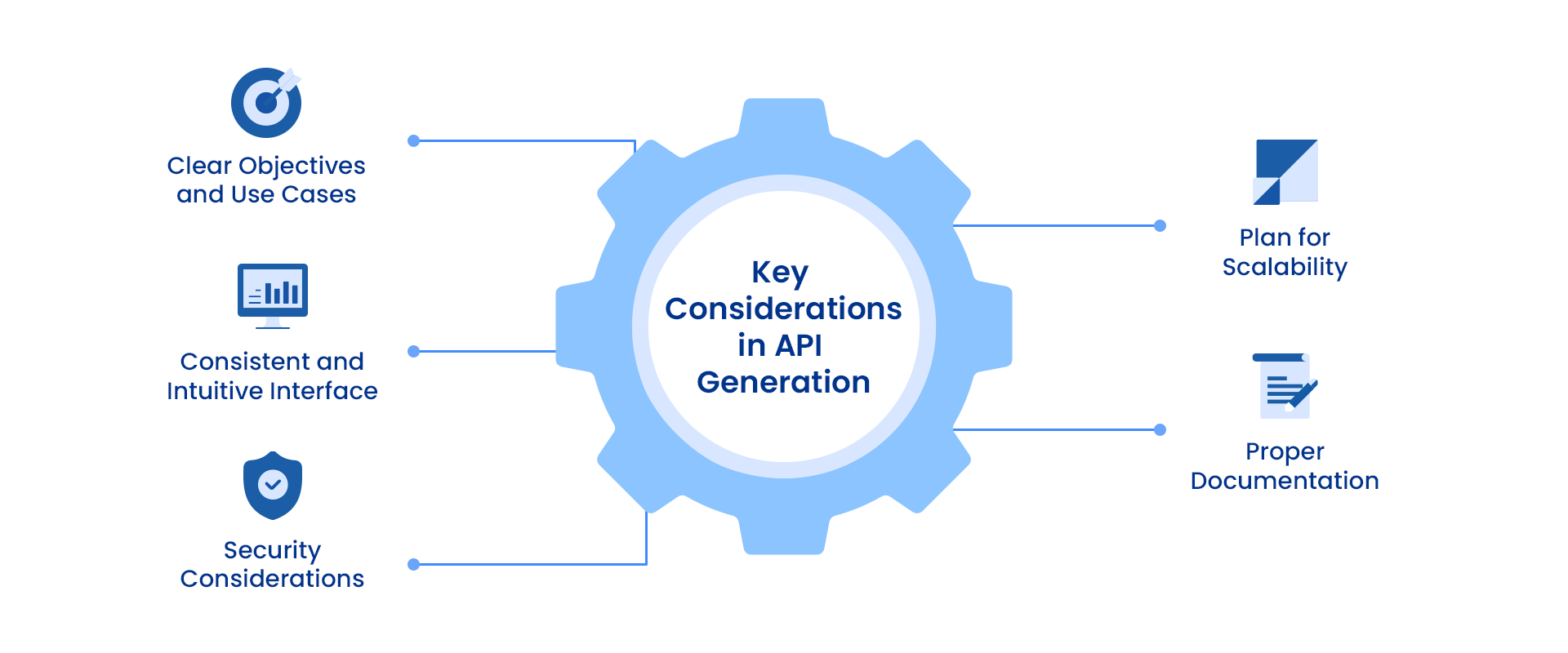
A Complete Guide to API Generation
What is API Generation?
API generation automatically creates an API based on pre-defined code and specific requirements, such as data access methods. APIs are the essential unit of a hybrid integration platform (HIP), an architectural approach to connecting everything or anything through a digital pulse. In this hustle to connect everything digitally, organizations need a process to acquire safe and secure APIs. API generation can make this happen, allowing companies to generate and deploy APIs without writing code.
APIs can be generated manually or with tools. Each approach has its own benefits and use cases. Manual generation offers flexibility, customization, and control. In contrast, API generation tools can automate the process of API creation and provide consistency and maintenance.
How Does API Generation Work?

API generation uses specialized tools to create structure, endpoints, and API documentation. A typical API generation workflow consists of the following:
-
Data Source Selection
The first step is identifying the data source the API will expose. It can be a NoSQL database, a relational database, a cloud storage service, or even a collection of flat files. API generation tools offer connectors for various data sources, simplifying selection.
-
API Definition
Once the data source is chosen, the tool defines the API’s functionality.
- It specifies the API endpoints and the specific URL paths that users will interact with to access or manipulate data, like CRUD (Create, Read, Update, Delete) operations on the data.
- Another functionality is defining the format of data received by the API (e.g., JSON, XML) and the format of data returned in responses (e.g., JSON, CSV).
- API generation tools often integrate with existing authentication mechanisms to specify user access controls for different API endpoints.
- Some API generation tools offer advanced features, such as data validation, transformation capabilities, and task automation, for more complex API functionalities.
-
Automatic Code Generation
The next step is to generate the actual code based on the data source selection and API definition. The automatically generated code has the following properties.
- The server-side logic is responsible for connecting to the data source, processing requests, and retrieving or manipulating data as per API endpoint definitions.
- The code converts data between its native format in the data source and the API’s chosen request/response format.
- It also handles potential errors that may occur during data access or processing.
-
Documentation Generation
API generation tools often automatically create API documentation. This documentation typically includes:
- A high-level description of the API’s purpose and functionality.
- Detailed explanations of each API endpoint, including request parameters, response structure, and error codes.
- Instructions on how users can access the API and the permissions required for different operations.
-
Deployment and Testing
The final step is to deploy the API to the server environment. API generation tools offer integration with popular cloud platforms or containerization technologies to streamline deployment. After deployment, API testing is important to ensure the API functions properly and adheres to the best security practices.
Alternative Ways of Generating APIs
The core purpose of an API is to bridge different applications together. This connectivity enables seamless data exchange and functionality sharing. The typical workflow for API generation remains constant. Still, multiple approaches to developing or creating an API exist, each offering its benefits and considerations.
Manual Development
Manual development involves writing code entirely from scratch using a chosen programming language. Developers have complete control over every aspect of the API’s functionality and performance.
Manual development offers control and allows developers to tailor the API to meet specific needs and integrate complex functionalities. Hand-coding can also prove helpful in high-volume data processing scenarios.
The most important consideration of manual coding is that it is a lengthy process that requires skilled developers with in-depth knowledge of API development. Maintaining and updating a manually written API is also a hassle as codebases become complex.
Low-code API Development Tools
Low-code API tools provide a visual interface with drag-and-drop functionalities and pre-built components, reducing the need for extensive coding.
Low-code tools cater to developers of varying skill levels, allowing them to contribute to API development. They also generate well-structured code that simplifies future maintenance.
The limitation of utilizing a low-code tool is that developers need to switch platforms if they need to rewrite code sections that rely heavily on client-specific functionalities. Users can connect to data sources, define API endpoints, and configure access controls through these tools.
No-code tools democratize API development, allowing non-technical users to create basic APIs. These tools enable rapid prototyping of API concepts, facilitating early feedback and iteration cycles. Utilizing no-code tools for API development eliminates the need for expensive developer resources. No-code tools also offer advanced functionalities, like built-in connectors, to handle complex APIs.
API Generators
API generators focus solely on generating code-based API on user-defined specifications. Users provide details about the data source, desired functionalities, and access controls. The tool then generates the code for a functional API.
API generators automate code generation, minimizing the potential for human error during coding. The automatically generated code also adheres to consistent formatting and best practices, enhancing code quality.
API Generation Tools (Advanced)
These tools offer functionalities like API generators but with additional capabilities. They provide features like data transformation, workflow orchestration, and advanced security configurations.
API generation tools cater to a broader range of API development needs, including data transformation and integration with existing workflows. Advanced features like data validation and transformation can simplify the overall API development process.
API generation tools can often manage API throughout its life cycle. They offer security features to ensure secure API access and data protection.
Manual Development vs. Auto API Generation
The difference between manual and automatic API generation is the whole process. While developers must write code and develop API from scratch, Auto API generation can automatically create and deploy the same API in a few clicks.
|
Manual API Generation |
Auto-API Generation | |
| Developer Involvement | Requires extensive developer involvement. | Minimal developer involvement; automated process. |
| Time Consumption | Time-consuming; requires manual coding. | Time-efficient; generates APIs automatically. |
| Error Frequency | Prone to human error in coding and integration. | Reduced risk of errors; automation minimizes mistakes. |
| Flexibility | Limited flexibility tied to developer expertise. | More flexible; can adapt to changing requirements. |
| Maintenance | High maintenance effort; manual updates required. | Low maintenance effort; updates are automated. |
| Documentation | Documentation quality depends on developer effort. | Consistent documentation quality; auto-generated. |
| Ease of Integration | Integration may be complex because it requires further manual coding for integration. | Seamless integration: APIs are generated for easy integration as they adhere to standardized formats. |
| Cost Efficiency | Higher development costs due to manual effort. | Cost-effective; reduces development expenses. |
| Version Control | Manual version control is needed, leading to consistency. | Automated version control ensures consistency. |
| Testing Requirements | Extensive testing is required as every line needs to be tested to ensure functionality. | Testing is streamlined due to standardized auto-generated APIs. |
| Debugging | Debugging can be challenging as it examines the code from scratch. | Debugging is simplified with features like Preview Raw Request/Response and auto-generated test flows/requests for testing. |
Benefits of Leveraging API Generation Tools
The easiest and quickest way to generate an API is to leverage an API generation tool. These tools automate the hefty process of creating APIs and eliminate the need for manual coding. Utilizing these tools provides multiple benefits, like
- API generation tools speed up API development by automating code, documentation, and client library creation from existing code or specifications, saving time and effort.
- API generation tools enforce best practices to maintain consistent API design and meet industry standards, lowering the risk of errors or inconsistencies in API implementation.
- These tools enforce best practices, ensuring consistent API design that adheres to industry standards (REST, GraphQL, OpenAPI). This reduces errors and simplifies integration.
- APIs built with generation tools are well-documented and self-explanatory, easing maintenance and comprehension for new developers. These tools also automatically update the API when underlying code changes, minimizing errors.
- APIs built with generation tools often follow standardized formats, enabling them to integrate more easily with other systems and applications.
- Modern API generation tools have code templates and libraries that allow code reuse and consistency across different organizational APIs.
- API generation tools enable developers to concentrate on their applications’ core functionality instead of implementing a detailed API, enhancing productivity and speeding up project timelines.
Key Considerations in API Generation
Multiple approaches exist to creating APIs, but all these perspectives need proper planning and consideration to ensure efficiency and user satisfaction. Five essential factors must be considered while developing an API.
-
Clear Objectives and Use Cases
Before starting to code, define the API’s purpose and the specific problems it aims to solve. Who will use the API: is it for internal purposes, third-party developers, or both? Identifying clear use cases is crucial for designing a focused, user-centered API that meets the project’s objectives.
-
Consistent and Intuitive Interface
API’s interface design dramatically affects how easy it is to use. A good API design is clear and straightforward, even for developers new to the project. It should use consistent names, HTTP verbs, and error handling for a smooth experience. Careful design makes the API easier to learn, helping developers integrate it faster and with fewer mistakes.

-
Security Considerations
Vulnerabilities can cause data breaches, unauthorized access, and system compromises. In API generation, organizations should use proper authentication and authorization to protect the API’s resources. They should also utilize HTTPS to encrypt data and prevent eavesdropping. Auditing and updating security also help prevent threats.
-
Plan for Scalability
Design the API to handle growth to keep performance smooth. If needed, use caching, load balancing, and distributed databases to scale the API. Scalability ensures a good user experience and prepares the app for future growth.
-
Proper Documentation
Complete and proper documentation is critical to the API’s success. It helps developers learn how to use the API, solve problems, and integrate it easily into their apps. Ensure that you include clear examples, use cases, and descriptions of endpoints.
Conclusion
API generation is a complex but necessary process for seamless connectivity. Though there are multiple ways and approaches to generating these APIs efficiently, API generation tools have emerged as the most efficient ones. They save time, resources, and an organization’s overall development cost.
With tools like Astera, generating APIs becomes more streamlined. With its exhaustive features and intuitive interface, Astera accelerates API development. It also offers added functionalities like extensive connectors, a drag-and-drop interface, and a zero-code environment to auto-generate CRUD APIs for the database.
If you are interested in generating hassle-free APIs, schedule a demo to experience the easiest and most efficient way to create an API.
Leverage Astera to Restructure Your API Development
Experience Astera's API generation tool firsthand. Simplify your workflow with intuitive features designed to enhance productivity and connectivity. Schedule a demo now and elevate your API development.
Request a Demo





